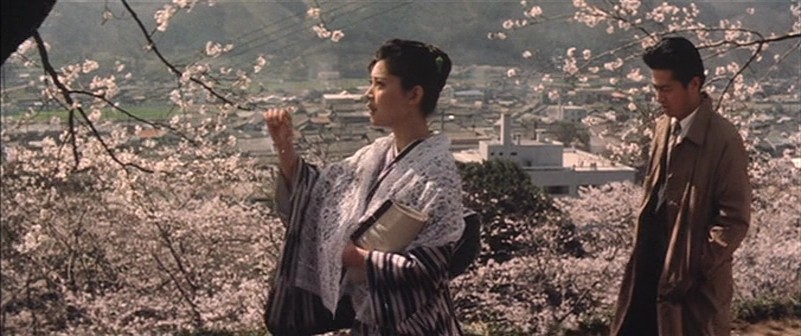
"An Affair at Akitsu" , courtesy of BFI
News29 September 2017
Tears and Laughter: Women in Japanese Melodrama at the BFI, 16 October to 29 November 2017
Categorised under: Art & Exhibitions, Grants, Theatre & Film
Running at BFI Southbank from Monday 16 October – Wednesday 29 November, Tears and Laughter: Women in Japanese Melodrama will be an opportunity for audiences to explore the cinema of Japan’s ‘Golden Age’, with a distinctly female focus. This Sight & Sound Deep Focus season includes several titles rarely screened in the UK, such as The Mistress (Shirō Toyoda, 1953), An Inlet of Muddy Water (Imai Tadashi, 1953) and The Blue Sky Maiden (Yasuzo Masumura, 1957), and
spotlights the magnificent female actors who starred in them. These include figures such as Setsuko Hara, one of Ozu’s key collaborators, Kinuyo Tanaka, the actor who became one of Japan’s first female directors and who was hailed in the West as ‘Japan’s Bette Davis’, and Machiko Kyō, best known as the star of Kurosawa’s Rashomon (1950). All of these stars endure as beloved icons of Japanese cinema, and their performances shine just as brightly as they did over fifty years ago.
The ‘Golden Age’ spanned the years following WWII to the early 1960s, an era when each year brought new masterpieces from directors such as Yasujirō Ozu, Kenji Mizoguchi and Mikio Naruse. It was a time of great social change for women in Japan, and what distinguished many of the films being screened in the season was the attention they gave to issues concerning women – frequently contained in heart-rending melodrama that rivalled Douglas Sirk for emotional impact. There will be
a season introduction on Tuesday 17 October – Women in Japanese Melodrama – during which experts including Alexander Jacoby and Alejandra Armendáriz will share their insights and reflect upon the work of powerful female icons at the heart of mid-century Japanese cinema.
The season opens with a double bill of films by the great Kenji Mizoguchi: Osaka Elegy (1936) is a tragic tale of entrapment and compromise that established his reputation as the greatest director of the plight of women in Japanese society, while Women of the Night (1948) is his rawest and most despairing film, shot with a stark, neorealist immediacy in the now-devastated Osaka in the wake of WWII. ‘Japan’s Bette Davis,’ Kinuyo Tanaka was one of Japanese cinema’s best-loved stars and finest actors and in Women of the Night she gives a performance of animalistic ferocity as a woman whose
life is torn apart by the conflict, and in desperation turns to prostitution. Tanaka also stars in Wedding Ring (Keisuke Kinoshita, 1950) as a woman who falls for the dashing, strapping doctor who is treating her bed-bound husband. Not only one of Japan’s greatest actresses, Tanaka was one of Japan’s first female directors, making six features, including The Eternal Breasts (1955) a powerful, frank film about the poet Fumiko Nakajō, who died of breast cancer aged 31 in 1954. Tanaka brings
an unmistakeably female perspective to recounting Nakajō’s life – from divorce through single motherhood, illness and her growing independence in life and love as her literary reputation grows. Glamorous and sensual, Machiko Kyō was a new kind of female star in the 1950s. Shortly after starring in Akira Kurosawa’s Rashomon (1950), she gave a superb performance in Kōzaburō Yoshimura’s Clothes of Deception (1951), a story of the contrasting fate of two sisters in a post-war Japan caught between the old and the new. Hideko Takamine was capable of registering the deepest emotion in merely a glance – a quality vividly displayed in Shirō Toyoda’s heart-breaking The Mistress (1953) as well as the searing tale of amour fou Floating Clouds (Mikio Naruse, 1955). The influence of Douglas Sirk’s contemporary melodramas is unmistakeable in The Blue Sky Maiden (Yasuzo Masumura, 1957) and The Shape of Night (Noboru Nakamura, 1964). The former is a fresh,
colourful and sharply satirical Cinderella story, the first in a string of collaborations with Ayako Wakao. The latter is an intoxicating rediscovery following a woman, played by Miyuki Kuwano, who is pushed into prostitution by her violent yakuza boyfriend. Gorgeously shot in widescreen, with bold compositions and editing, Nakamura’s revelatory film absorbs Sirk’s expressive use of colour, while pointing forward to the lyrical modernism of Wong Kar Wai. Yoshiko Kuga gives a performance of great sensitivity in Elegy of the North (Heinosuke Gosho, 1957), an exquisitely shot melodrama. Mariko Okada’s career bridged both the Golden Age and the New Wave she helped to define in the films she made with her director husband Yoshishige Yoshida. One of the first films they made together was An Affair at Akitsu (1962), a hauntingly intense melodrama of unrequited love and post-war disillusion, shot in lush widescreen colour. Completing the season is
Tokyo Twilight (Yasujirō Ozu, 1957) starring Japan’s ‘eternal virgin’ Setsuko Hara, who here shows another side to her acting, in Ozu’s unusually downcast and melodramatic masterwork, which spans teenage pregnancy, abortion and maternal abandonment.